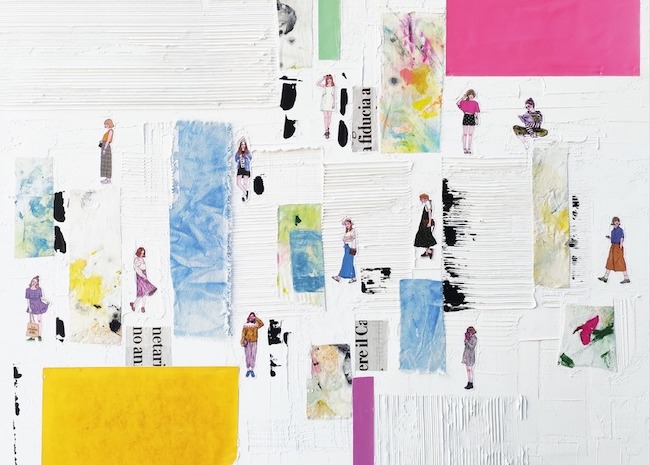Esistono istanti in cui osservare la realtà con tutta la sua evidente severità e altri in cui nascondersi dentro un mondo più morbido, melodico, che diviene un rifugio all’interno del quale coltivare tutte quelle emozioni positive che non possono essere contaminate o sopraffatte dagli accadimenti circostanti; questa alternanza emozionale contraddistingue gli artisti che hanno bisogno da un lato di non perdere il contatto con la contemporaneità ma dall’altro la oltrepassano scegliendo di credere che attraverso la bellezza, l’armonia e l’equilibrio sia possibile generare un mondo migliore. A questa categoria di creativi appartiene Gessica La Pira che nella sua nuova produzione pittorica va a evidenziare l’avvicendamento di percezioni, quella più oggettiva e quella più soggettiva, che emerge dal suo stile personale e riconoscibile.
La fine della prima metà del Novecento vide avvicendarsi movimenti decisamente sperimentali che in qualche modo riassunsero e rielaborarono le teorie più estreme delle avanguardie che li avevano preceduti, mostrando sia il desiderio di continuare a trovare nuove modalità e tecniche espressive e sia una rinnovata esigenza di andare verso il grande pubblico, di dar vita a un linguaggio che potesse essere compreso dalla nuova borghesia emergente, che di fatto stava dettando le leggi del mercato. Laddove la Pop Art più tradizionale si propose come capostipite di questo tipo di approccio, utilizzando simboli e personaggi popolari, appunto, dall’altro vi furono alcuni movimenti coevi che ebbero minore diffusione ma che sono stati altrettanto rilevanti nella storia dell’arte moderna; i Neo Dada, spesso ed erroneamente considerati pop artists minori, furono coloro che raccolsero l’eredità dadaista mescolandola con le contaminazioni surrealiste, dando vita a uno stile dove la materia, in special modo quella di riciclo, poteva entrare a far parte dell’opera applicando così a una figurazione riconoscibile le teorie dell’Informale Materico. Robert Rauschenberg fu uno dei maggiori esponenti del movimento e le sue opere pittoriche presentavano la caratteristica di uscire dal Minimalismo monocromatico che lo aveva rappresentato nelle sue prime sperimentazioni artistiche, per presentare collage e riferimenti alla quotidianità e all’attualità. L’eco neodadaista giunse anche in Europa dove i francesi risposero con il Nouveau Réalisme in cui tutta la materia era accettata e l’oggetto assumeva rilevanza per la sua reale essenza; a questo movimento appartenevano anche gli affichistes di cui Mimmo Rotella fu il rappresentante più emblematico, il cui collage, che aveva contraddistinto Rauschenberg, era costituito da parti di manifesti pubblicitari strappati e poi riassemblati in maniera casuale e incollati sulla tela. Il fascino del messaggio emergente da questi due movimenti era generato da un lato dal tipo di linguaggio immediatamente comprensibile dall’osservatore proprio perché riferito a eventi o a simboli contemporanei a quel periodo, ma dall’altro emergeva in un secondo momento la riflessione sui significati e le considerazioni più profonde sulla società, sull’attualità e sul mondo dell’arte. L’artista toscana di origini siciliane Gessica La Pira assorbe le esperienze pittoriche di questi due movimenti unendole e mescolandole alla sua tendenza lirica espressa con tele monocromatiche bianche che la fanno tendere verso un Minimalismo particolarmente morbido, suggestivo in virtù del silenzio che generano e che in virtù della sovrapposizione di materiali, dalle stoffe alle carte da parati, inducono alla riflessione sulla stratificazione della realtà, sui diversi livelli di conoscenza e di consapevolezza che si raggiungono di volta in volta apprendendo quanto sia necessario dover approfondire e svelarsi per evolvere.
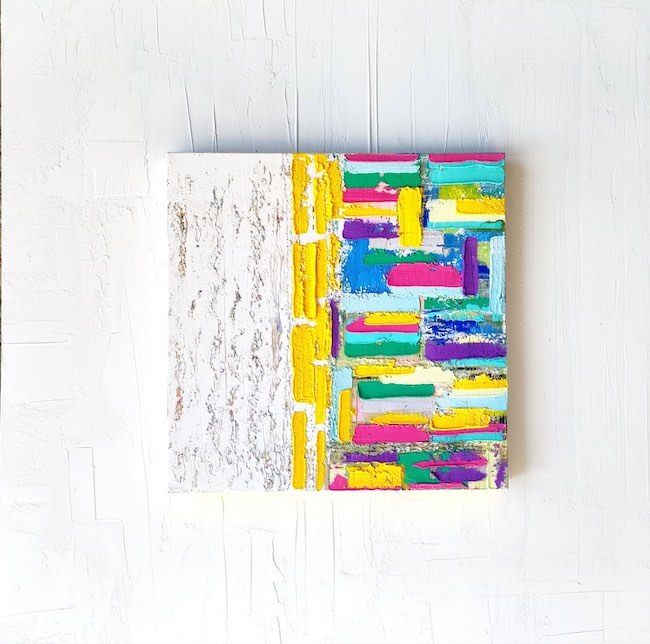
La sottile quiete delle parti monocrome viene destabilizzata dall’introduzione del collage Neo Dada di cui a volte è protagonista il colore, altre lo sono le parole, e alcune la figura femminile, come se Gessica La Pira volesse ancora una volta mettere in evidenza ciò che non può fare a meno di rivelarsi e di essere osservato delle vicende attuali, pur mantenendosi in equilibrio con quella necessità di equilibrio armonico che contraddistingue le sue tele e anche la sua essenza espressiva.
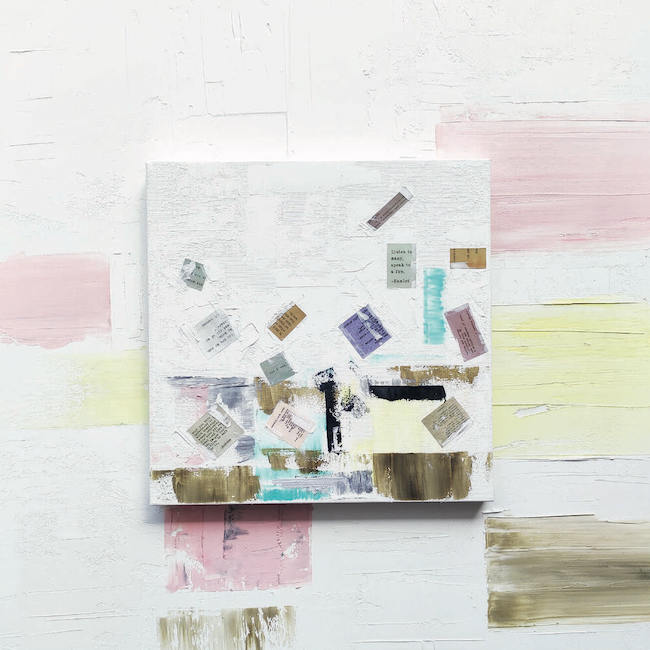
Le sovrapposizioni in questa nuova serie che tende verso il Neo Dada, si aprono a maggiori possibilità, accettano la destabilizzazione di un elemento più forte, meno soffuso, proprio perché l’artista ha scelto di far sentire voci che non sempre possono essere escluse, quelle degli accadimenti esterni che segnano inevitabilmente il corso della storia contemporanea alla quale si sta assistendo; la donna, protagonista assoluta delle quattro tele denominate Manifesto, diviene dunque figura centrale per sottolineare quanto ancora ci sia bisogno di sensibilizzare il pubblico su un ruolo che solo recentemente ha cominciato a uscire dal silenzio nel quale è stato costretto per molti anni, e che forse proprio in virtù della nuova emancipazione si trova in situazioni a volte difficilmente gestibili.
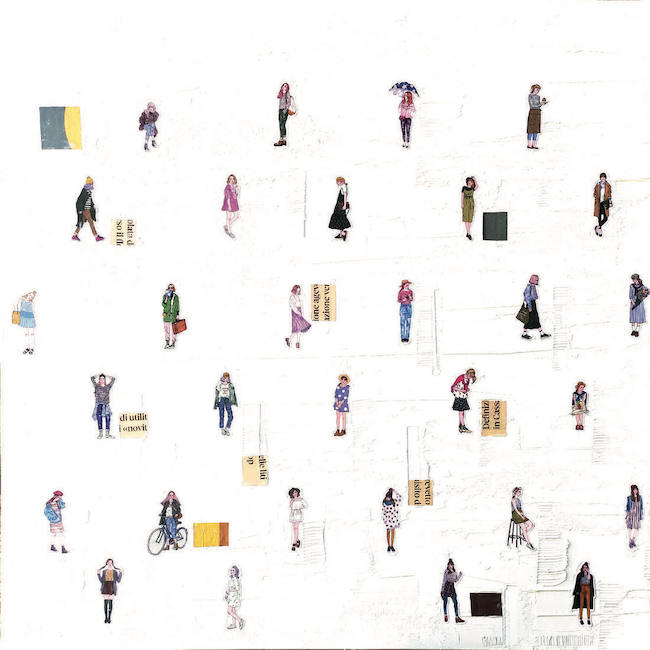
Forte ma anche sensibile, di fatto la donna può costituire una necessaria connessione tra ciò che accade e le modificazioni che la società dovrebbe generare proprio a seguito di quegli avvenimenti, come se solo attraverso una forte sensibilità ed empatia fosse possibile generare qualcosa di bello. Il collage composto da figurine di moda con abiti rielaborati a mano viene disposto in modo minimalista sulle basi costituite da gesso e cemento bianco su tela, proprio per sottolineare quanto l’individualità, e non l’individualismo, sia fondamentale per mantenersi collegate con la propria interiorità osservando il mondo esterno come contorno essenziale, ma mai atto a modificare la sostanza dell’anima.
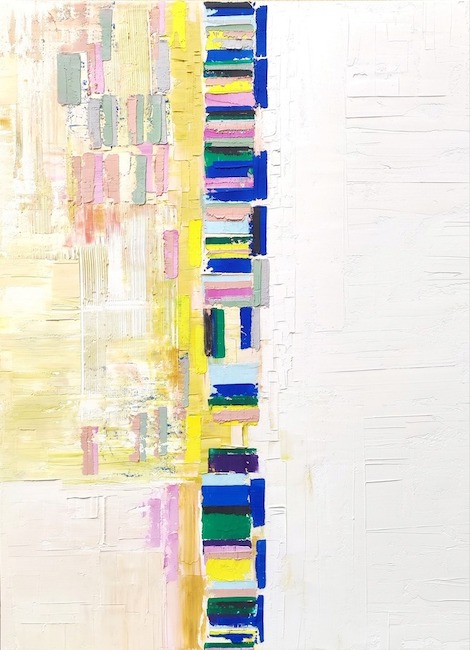
La serie Tra il visibile e l’invisibile verte invece sull’interazione dell’interiorità con voci che fuoriescono come dei veloci fotogrammi di realtà, piccole finestre sul mondo costituite in maniera alternata da ritagli di giornale o da semplici pennellate di colore regolari, quasi geometriche, ma comunque in grado di costituire un elemento di rottura dell’ordine sottostante evocato dal bianco. La calma armonia di base viene dunque disturbata dall’impatto con una realtà che in alcuni casi si manifesta sotto forma di parole, ritagliate e posizionate all’interno della composizione come se fossero istanti di consapevolezza che un attimo dopo devono necessariamente rientrare nell’ordine interiore di Gessica La Pira, evidenziando la necessità di rifugiarsi in un mondo di bellezza, di naturalezza che spesso entra in contrasto con il caos generato dalla società attuale che induce l’individuo a desiderare di sfuggire alle sue dinamiche.
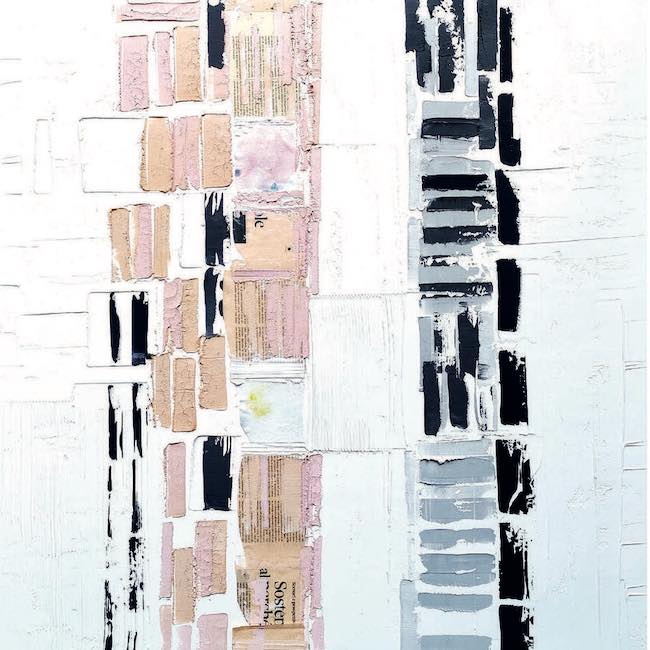
La perdita dei valori, la costante destabilizzazione provocata dagli eventi mondiali, l’apparente impossibilità di perseguire un bene duraturo, sono le tematiche che l’artista fa sottilmente e delicatamente fuoriuscire affinché l’osservatore rifletta e consideri un’altra opzione, quella appunto di trovare una dimensione differente, calma, avvolgente, che in fondo corrisponde a quel mondo emotivo troppo spesso nascosto e dimenticato dietro la durezza del vivere.
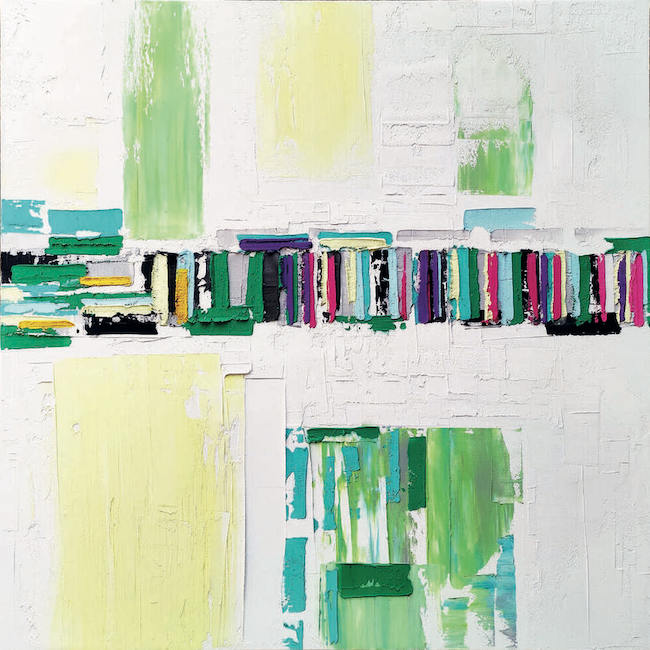
La melodia interiore viene perciò stimolata dalle tele di Gessica La Pira, sottintendendo quanto non sia necessario escludere la parte migliore del sé, rendendo piuttosto molto più funzionale l’impulso a recuperare quell’equilibrio che gli eventi e le circostanze vorrebbero far sfuggire; l’opera Pianoforte mostra in tutta la sua vibrazione questo fascino comunicativo, le tonalità scelte sono vivaci e intense nella parte più frammentata, poi però si sfumano man mano che se ne allontanano fino a perdersi nel bianco puro dello sfondo, che comunque è sfaccettato, stratificato come d’altronde lo è la vita, metafora dello sforzo di costruire se stessi, evento dopo evento, circostanza dopo circostanza.
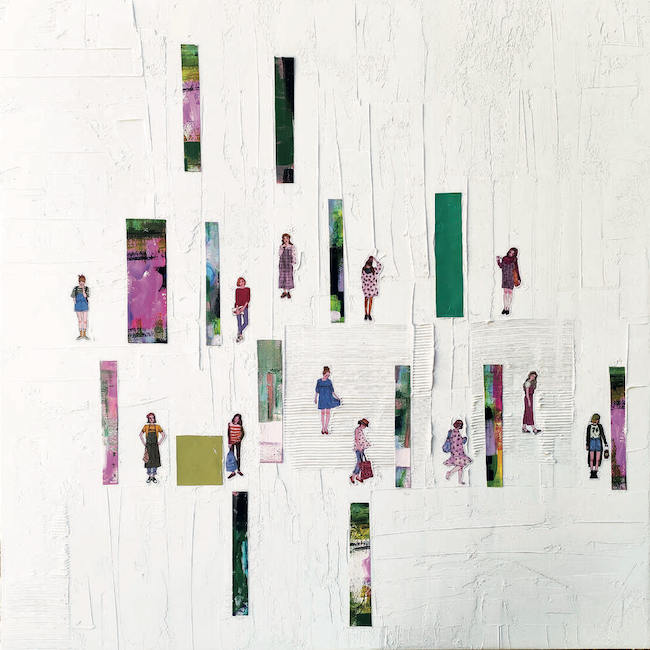
Dunque il Minimalismo di Gessica La Pira si unisce alla sua tendenza a sperimentare materiali diversi e insoliti, ed è qui che il suo stile tende verso il Neo Dada, perché la sua pittura non è mai pura, è costantemente mescolata con gessi, terre colorate, stoffe dipinte, cemento e marmo di Carrara; la materia diviene dunque ulteriore messaggio compositivo ed espressivo perché in qualche modo sembra essere un riferimento a quella concretezza, a quel bisogno innato di restare legati alla realtà che appartiene all’essere umano, da cui però è possibile sollevarsi per credere nei sogni, nell’armonia e nella poesia, nella fiducia che sia solo attraverso l’elevazione, l’ascolto dell’interiorità in connessione con la natura, che sia possibile trovare la dimensione all’interno della quale vivere una vita migliore e distante dagli squilibri provocati dall’uomo. Gessica La Pira è stata inserita nell’edizione 2024 dell’Atlante dell’arte contemporanea edito da Giunti Editore in collaborazione con Start Group, e patrocinato dal Metropolitan Museum of Art di New York, e ha al suo attivo mostre collettive in Italia e all’estero. La mostra Frammenti. Tra il visibile e l’invisibile, che vedrà esposte per la prima volta le nuove opere, avrà luogo dal 16 aprile al 5 novembre presso lo Spazio Espositivo in via dell’Opio nel Corso, 12 a Montepulciano (SI).
GESSICA LA PIRA-CONTATTI
Email: lapira.secondoatto@gmail.com
Sito web: http://www.gessicalapira.it/coming-soon/
Facebook: https://www.facebook.com/gessica.lapira
Instagram: https://www.instagram.com/gessica_lapira/
The lyrical digressions by Gessica La Pira, between Neo Dada collages and evocative Minimalist settings
There are moments in which to observe reality with all its evident severity and others in which to hide inside a softer, melodic world that becomes a refuge where cultivating all those positive emotions that cannot be contaminated or overwhelmed by the surrounding events; this emotional alternation distinguishes artists who, on the one hand, do not want to lose contact with contemporaneity, but on the other hand, go beyond it, choosing to believe that through beauty, harmony and balance it is possible to generate a better world. Gessica La Pira belongs to this category of creative artists. In her new pictorial production, she highlights the alternation of perceptions, the more objective and the more subjective, which emerges from her personal and recognisable style.
The end of the first half of the 20th century saw a succession of decidedly experimental movements that in some ways summarised and reworked the more extreme theories of the avant-gardes that had preceded them, showing both a desire to continue to find new modes and techniques of expression and a renewed need to reach out to the general public, to create a language that could be understood by the newly emerging bourgeoisie, which was in fact dictating the laws of the market. While the more traditional Pop Art proposed itself as the forerunner of this type of approach, using popular symbols and characters, there were, on the other hand, a number of coeval movements that were less widespread but equally relevant in the history of modern art; Neo Dada, often and erroneously considered minor pop artists, were those who took up the Dadaist heritage and mixed it with Surrealist contaminations, giving life to a style where material, especially recycled one, could become part of the artwork, thus applying the theories of the Material Informal to a recognisable figuration.
Robert Rauschenberg was one of the major exponents of the movement and his pictorial works had the characteristic of moving away from the monochromatic Minimalism, that had represented him in his early artistic experiments, to present collages and references to everyday life and current affairs. The neo-Dadaist echo also reached Europe where the French responded with Nouveau Réalisme in which all matter was accepted and the object assumed relevance for its real essence; to this movement also belonged the affichistes of which Mimmo Rotella was the most emblematic representative, whose collage, which had distinguished Rauschenberg, was made up of parts of advertising posters torn and then reassembled in a random manner and glued onto canvas. The fascination of the message emerging from these two movements was generated on the one hand by the type of language that was immediately comprehensible to the observer precisely because it referred to events or symbols contemporary to that period, but on the other hand, emerged later the reflection on the deeper meanings and considerations on society, events and the world of art. The Sicilian-born Tuscan artist Gessica La Pira absorbed the pictorial experiences of these two movements, uniting them and mixing them with her lyrical tendency expressed with white monochrome canvases that make her tend towards a particularly soft Minimalism, suggestive by virtue of the silence they generate and that for the overlapping of materials, from fabrics to wallpapers, induce a reflection on the stratification of reality, on the different levels of knowledge and awareness that are reached from time to time by learning how necessary is to deepen and reveal oneself in order to evolve.
The subtle stillness of the monochrome parts is destabilised by the introduction of the Neo Dada collage in which sometimes the protagonist is the colour, sometimes the words and sometimes the female figure, as if Gessica La Pira once again wanted to highlight what cannot help but expose itself and be observed in current events, while maintaining the need for harmonious balance that characterises her canvases and also her expressive essence. The superimpositions in this new series, which tends towards Neo Dada, open up to greater possibilities, accepting the destabilisation of a stronger, less suffused element, precisely because the artist has chosen to make heard voices that cannot always be excluded, those of the external events which inevitably mark the course of the contemporary history we are witnessing; the woman, the absolute protagonist of the four canvases called Manifesto, thus becomes a central figure to emphasise how much there is still a need to raise public awareness of a role that has only recently begun to emerge from the silence in which it has been confined for many years, and that perhaps precisely by virtue of the new emancipation finds itself in situations that are sometimes difficult to manage. Strong but also sensitive, women can in fact constitute a necessary connection between what happens and the changes that society should generate precisely as a result of those events, as if only through strong sensitivity and empathy is it possible to generate something beautiful.
The collage made up of fashion figurines with hand-rendered clothes is arranged in a minimalist manner on bases consisting of chalk and white cement on canvas, precisely to emphasise how individuality, and not individualism, is fundamental in order to remain connected to one’s inner self by observing the external world as an essential outline, but never capable of altering the substance of the soul. The series Between the Visible and the Invisible focuses instead on the interaction of interiority with voices that emerge like quick frames of reality, small windows on the world made up alternately of newspaper clippings or simple regular, almost geometric brushstrokes of colour, but nevertheless capable of constituting an element of rupture to the underlying order evoked by the white. The basic calm harmony is therefore disturbed by the impact with a reality that in some cases manifests itself in the form of words, cut out and positioned within the composition as if they were instants of awareness that a moment later must necessarily re-enter Gessica La Pira‘s inner order, highlighting the need to take refuge in a world of beauty, of naturalness that often contrasts with the chaos generated by today’s society that induces the individual to desire to escape its dynamics. The loss of values, the constant destabilisation provoked by world events, the apparent impossibility of pursuing a lasting good, these are the themes that the artist subtly and delicately brings out for the observer to reflect on and consider another option, that of finding a different, calm, enveloping dimension, which after all corresponds to that emotional world too often hidden and forgotten behind the harshness of living.
The inner melody is therefore stimulated by Gessica La Pira‘s canvases, implying that it is not necessary to exclude the best part of the self, making the impulse to recover that balance that events and circumstances would like to make slip away much more functional; the artwork Pianoforte shows this communicative charm in all its vibrancy, the tones chosen are lively and intense in the most fragmented part, but then fade away as they recede into the pure white of the background, which is in any case multifaceted, layered as life is, a metaphor for the effort to build oneself up, event after event, circumstance after circumstance. So Gessica La Pira ‘s Minimalism is combined with her tendency to experiment with different and unusual materials, and it is here that her style tends towards Neo Dada, because her painting is never pure, it is constantly mixed with plaster, coloured earths, painted fabrics, cement and Carrara marble; the material thus becomes a further compositional and expressive message because in some way it seems to be a reference to that concreteness, to that innate need to remain tied to reality that belongs to the human being, from which, however, it is possible to rise up to believe in dreams, in harmony and poetry, in the trust that it is only through elevation, listening to one’s inner self in connection with nature, that it is possible to find the dimension within which to live a better life, far from the imbalances caused by man. Gessica La Pira was included in the 2024 edition of the Atlas of Contemporary Art published by Giunti Editore in collaboration with Start Group, and sponsored by the Metropolitan Museum of Art in New York, and has group exhibitions in Italy and abroad to her credit. The exhibition Fragments. Tra il visibile e l’invisibile, which will see the new works exhibited for the first time, will take place from 16 April to 5 November at the Spazio Espositivo in via dell’Opio nel Corso, 12 in Montepulciano (SI).


